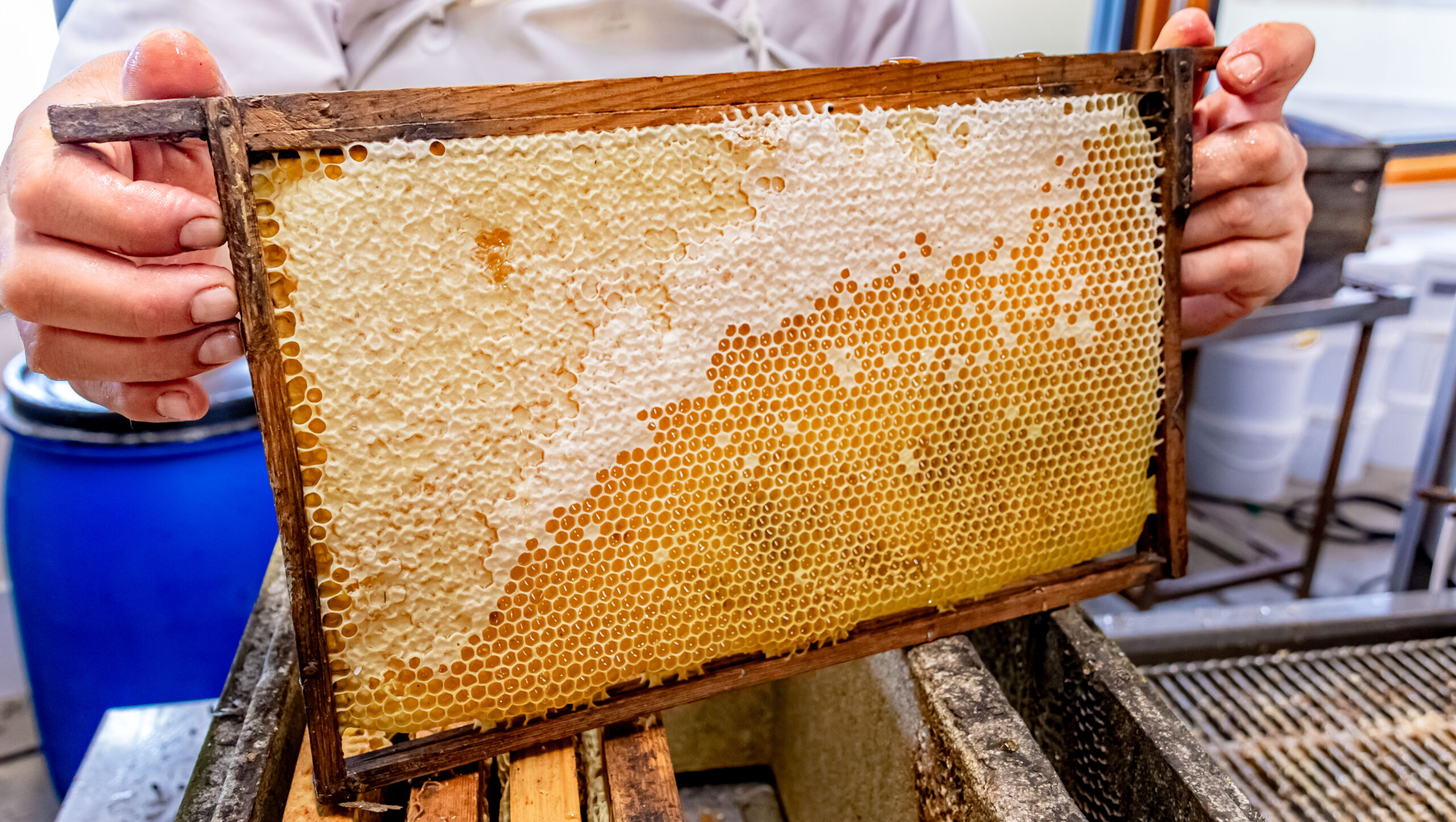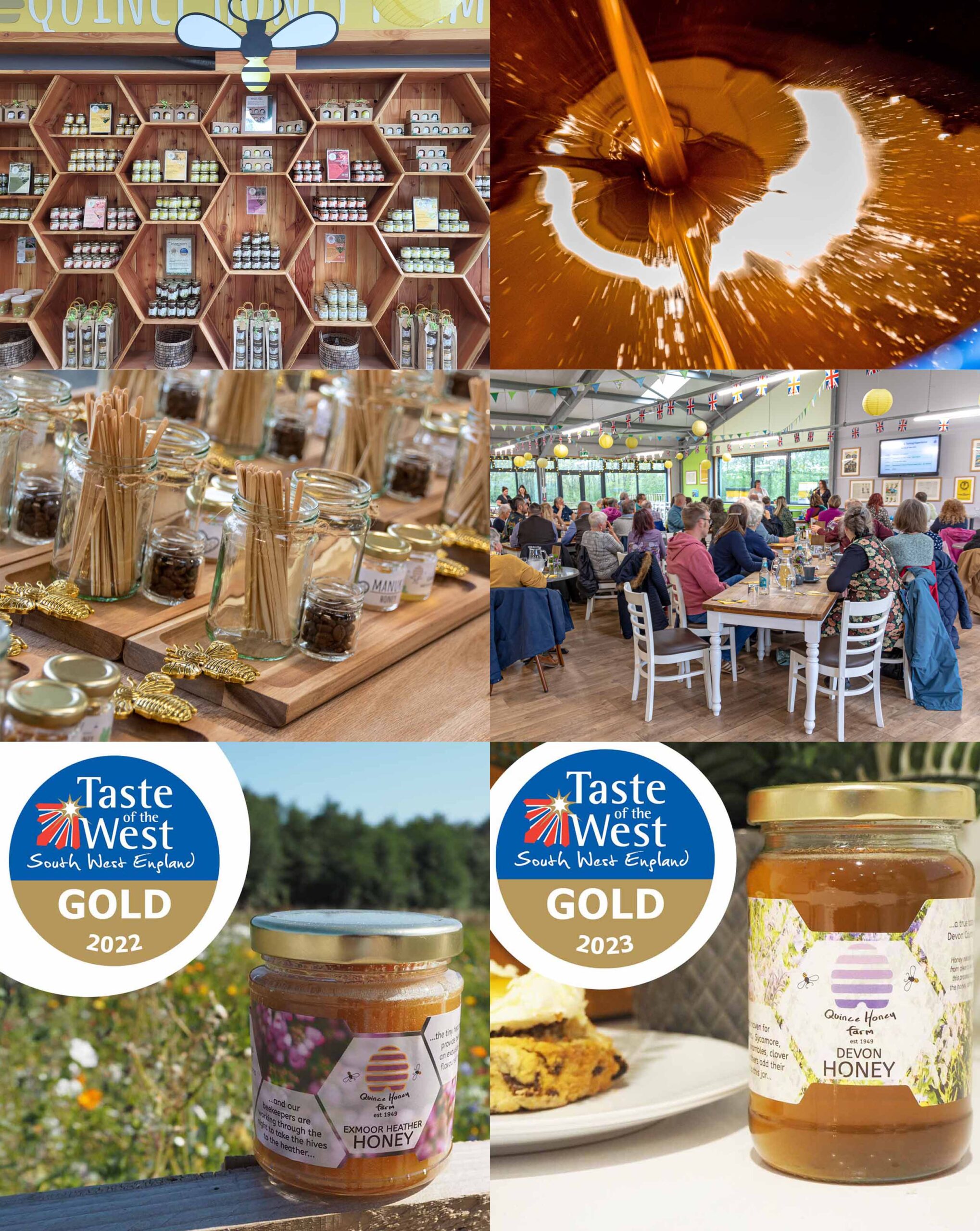Honey… the product of honey bees, made from nectar, the product of flowers. Also the drink of the gods (or so they say). We recently held a Honey Talk & Tasting Experience, back in May 2023, and for those of you who couldn’t make it we thought we’d give you a flavour of what you missed, blog-style. Just by reading this we think we can stimulate your senses and tickle your taste buds… let’s try it out.
We have to start with the bees, of course. Without bees there is no honey*. Scientists estimate there are around 20,000 species of bee worldwide, all having a lifecycle based around flowers, their pollen and nectar. Out of all of those species, it takes a honey bee* to make honey and across the world there is a grand total of just eight bee species we know of that make honey. An apiary is a location where beehives of semi-domesticated honey bees are kept and most honey production around the world comes from the species Apis mellifera – the western honey bee.
Another way of farming honey is through Honey Hunting of wild hives. This is an ancient tradition, requiring a little more patience than modern day beekeeping, using ancient techniques handed down through generations. It is still practiced today in certain parts of the world such as Africa, Asia, Australia and South America. The Honey Hunters of Nepal are a particularly fascinating bunch, hunting wild honey from cliff-nests of the Apis laboriosa, the largest honey bee in the world. I would call this “Extreme Honey Hunting” … involving many ropes and swinging from stomach-churning heights along vast cliff faces, they collect a honey known as Mad Honey! Not because of how they collect it, though. Mad Honey is a unique type of honey that has psychoactive properties, caused by grayanotoxins (a type of neurotoxin) found in the pollen of certain plants. When bees feed on the pollen of these flowers, the resulting honey brings a hallucinogen punch and is commonly called Mad Honey. The honey has a slightly bitter taste and reddish colour, and bees are more likely to produce Mad Honey when and where dense rhododendron forests exist, such as in Nepal. The scarcity of other plants and domination of rhododendron flowers, which are packed full of grayanotoxins, cause bees to consume more of it which result in the honey being …. well, pretty mad.
We don’t sell Mad Honey at Quince Honey Farm. Sorry!
In the UK, the sad truth is there are very very few truly wild colonies of honey bees left to hunt. The loss of their natural habitat means that most colonies now have a beekeeper to look after them and consequently they are no longer considered wild. The introduction of a parasitic mite by human activity has also been devastating for wild colonies.
But, regardless of how us greedy humans get our hands on the honey, how do honey bees actually make it? We sometimes call honey “Liquid Sunshine” and there is actually an element of truth in that expression. Inside the leaves of a plant, there are chloroplasts where sunlight is harnessed by the leaves and turned into glucose (sugar, the building block for all plant growth). Add some nutrients in the water, CO2 from the air, and the water itself, and the plant can create all the structures it needs. The plant grows a flower with the enticing nectar at its very core, the key ingredient of honey. The flower itself creates a cup shape at its centre and surrounds that cup with nectaries. They come in all shapes, colours and sizes but generally they are small protruding bumps and it is inside those nectaries that the nectar is formed, using sugars the plant has created from the sunlight. The point of the nectar, from the flower’s perspective, is to create an energy source that brings pollinators to them so that the flower’s pollen is spread and it can reproduce. It is, quite simply, a sweet sweet lure for the bees and butterflies – nectar is not used by the plant for itself.
The nectar will be around 80% water and 20% complex sugars, although this varies by species of flower. For our honey bees, generally (but not always) the sweeter the better. The nectar also has trace amounts of proteins, salts, acids and essential oils and these added extras can sometimes increase a pollinator’s preference for these flowers. For instance the coffea (coffee) flowers have nectar that includes very low levels of caffeine, creating just a little extra buzz around these flowers!
Before nectar becomes honey, it must first enter a honey bee’s stomach. While the honey bee is flying back to the hive, after foraging the flowers, the honey creation process has in fact already begun with the enzyme invertase starting to break down the nectar within their stomach. This foraging honey bee will pass its nectar load to her sister waiting at the hive entrance and then she goes back to the flowers for more. Her sister takes that nectar into the hive, continuing to break down the complex sugars and concentrating them further within her stomach. It is a team effort and the honey bee sisters share the workload, passing the nectar between them. When the unripened honey is almost ready it is placed into the hexagonal wax cells of the hive and, with a mixture of massaging the honey with their tongues to expose it to the air and using their wings to create a flow of warm air over the comb (bee air conditioning!), they ripen the honey to less than 20% moisture content. Finally, a wax cap is placed over the top of the cell and hey presto … perfectly ripened, delicious honey.
There are thousands of different types of honey across the world. All made by honey bees*, but they all taste different. Even from year to year, the same honey bee colony foraging the same area will produce a honey that tastes a little bit different to before. At Quince Honey Farm we have nine different types of honey that we harvest, depending on the season. Let’s move on to talk about the wonderful honeys of Quince Honey Farm (it is our blog, after all).
Our Devon Honey is a firm favourite and this year we were very proud when it was awarded the Taste of the West Gold award. It is a lovely runny multifloral honey that just glides down your throat. It has delicate aromas, a gentle sweetness with a mild but tasty flavour – perfect to go with everything! Our bees love foraging on the old-fashioned pastures and flower-rich hedgerows of Devon which are a haven for wildflowers. Sycamore, dandelions, blackberries, white clover, rosebay willowherb and many others add their nectar to this jar. It is a true taste of the Devon countryside!
Our Spring harvest brings in our Rapeseed honey, from the brassica family which sets quickly due to the high glucose content. It is a mild and light-coloured honey produced on the edges of farmers’ fields when their crop is in flower. This honey can set in the comb itself and we have to harvest this quickly! This fast setting creates fine crystals of glucose with a fructose syrup running throughout.
In late summer comes our Exmoor Heather and Scottish Heather honeys, popular but very different from the others. The hives are moved into these locations just before the heather comes into flower**. It is an unusual, flavoursome honey, and our Exmoor Heather honey won the Taste of the West Gold award last year in 2022. Heather honey has a thixotropic consistency, which means it only becomes more liquid when stirred, shaken, or agitated. When at its runny stage it actually has a jelly-like consistency. With a fabulous golden colour, floral notes but a subtle smokiness, we have to harvest this thicker honey by hand! Heather honey sets slowly and in stages so you have differing sized crystals that melt consecutively on your tongue, a peculiar consistency but absolutely delightful. While these honeys are both from heather, they are not the same and there is a difference in taste. The Scottish Heather honey, that I like to call the “Irn-Bru” honey, has a deeper depth of taste than our Exmoor Heather. This is down to the terroir – the soil, the rainfall, the temperatures, the minerals in that rainfall – all of which affect the heathers, which affect the nectar, which affect the honey. When they talk about the provenance of honeys, where they come from is just as important as the type of flower that produces the nectar.
Honey is not always a light or golden colour – it can be much darker. Generally there are two reasons honey becomes dark. Firstly, if you heat it too far in the microwave (NEVER confess this to a beekeeper) it produces hydroxymethylfurfural (HMF) which is degraded honey where the fructose molecules break down and form a dark bitter substance. We process our honey carefully to prevent the build-up of this substance. If you ever come across something called Bakers honey, it’s often lower quality honey with a bit too much heat – great for baking with but not much else. The other reason for a darker honey is the nectar source, often darker honeys have a deeper and more intense flavour. A great example, and the last one we’ll mention in this blog, is the Sweet Chestnut Honey – the bad boy of the honey family! Smoky, leathery, spicy and mysterious. Or, to put it another way, intensely bitter. Smell this first and you will get a hint of it’s tasting notes, then taste with care! I often describe this as “marmite” honey as you will either love it or hate it. Fructose is the dominant sugar in this honey and there are naturally occurring tannins within the nectar and hence the dark colour. This honey can hold its own even when paired with a gorgonzola or even a stilton cheese.
And so we conclude our honey journey, for the purpose of this blog anyway. We haven’t even mentioned the medicinal uses for honey! Let’s save that for another blog.
For the honey connoisseurs out there, watch out for a future event all about honey. We’re hoping to make it an annual thing. It is, after all, the nectar of the gods.
Blog written by Marie Shortt, Head of Education, Quince Honey Farm
* This is in fact a bit of a porky … to be explained further in a future blog.
**If you’re curious about how we harvest our honeys, check out our previous blog here: Our Honey Harvest – Quince Honey Farm
View our range of seasonal honeys on our online shop: Click Here
Photos …
- Our honey display in the gift shop of Quince Honey Farm
- Honey during extraction
- Honey tasting trays and the audience, at our Honey Talk & Tasting Experience in May 2023
- Our Taste of the West Gold winners in 2022 (Exmoor Heather Honey) and 2023 (Devon Honey)


Comments
comments for this post are closed